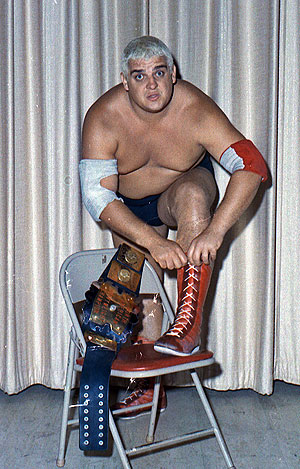Suffering, Defeat, and Justice: Why You Should Care About Pro Wrestling
Published on January 30th, 2012 in: Issues, Oh No You Didn't, Pro Wrestling, Sports, TV |If you watch a match between Dusty Rhodes and Ric Flair in their prime, the audience, while surely not all convinced of the authenticity of this fight, were still willing to suspend their disbelief. Watching wrestling—not as one who criticizes how one “sells” the pain of a submission hold or slam, but as someone in willing participation with the story—is now frowned upon by the wrestling communities which populate the Internet.

Dusty Rhodes
One only has to look at the disdain which is directed at John Cena, an admittedly limited but charismatic performer, on the basis of issues which could easily be levelled at Dusty Rhodes or any number of the wrestlers who populated the childhoods of those who grew up in the 1980s. This is a rejection of what is viewed as “childish.” The “real fans” are those who engage with—or feel they are engaging with—the backstage aspect of the business. Those who are cynical and hardened with self-importance.
In much the same way that the comic book industry wanted to establish itself as being worthy of the “Art” mantle in the 1980s, many wrestling fans and promotions feel that to be taken seriously they must “mature.” As Alan Moore—somewhat unfairly—said in an interview with Wired from 2009:
“If you remember back in the ’80s, there was an incredible spate of monumentally lazy headlines in British and American magazine and newspapers. But also something along the lines of ‘Bam! Sock! Pow! Comic Books Aren’t Just for Kids Anymore.’ I used to think those headlines were just irritating, but it’s only recently that I’ve looked back and realized how incredibly inaccurate they were. Comics had not grown up, bam-sock-pow. What had happened was that you’d gotten two or three comics that had gotten, perhaps for the first time, serious adult elements in their compositions. This was judged as miraculous as a dog riding a bicycle back in the 1980s. It doesn’t matter whether he’s riding it particularly well; it matters that he’s riding it at all.”
Wrestling fans have been looking for their Dark Knight Returns or a Watchmen for years. “We need something to legitimize us!” In doing this though, they ignore—as Moore arrogantly does—the reasons why people started loving Professional Wrestling in the first place. Wrestling did not “grow up” in the 1990s. It expressed, what was in retrospect, an even more child-like position to the public. Yes, the “Attitude Era” was filled with great wrestling but that had far more to do with the individuals in the ring and not with the “adult” themes.
These “adult themes” will surely be familiar to the Millers and Snyders of the world: plastic women, strip shows, and extreme violence. If you compare this with the match that Randy Orton had with John Cena during 2009’s Hell in a Cell, I think you can view what are the seeds of a genuine maturity. The match was criticized for being what amounted to a “visual arts performance.” This is another unstated rule; anything that can come across as “gay” or “arty” is by definition not a “grown up” vision of wrestling. If you can’t jerk off to something, whether through violent catharsis or a grandmother giving birth to a hand, then forget it.
It could be said that professional wrestling is all an effort in visual arts performance. It is also where wrestling has most feared to venture, to its continuing detriment. The days of WWE being an offshoot of SNL are long gone. The days when wrestling had real star power, up there with the Howard Sterns of pop culture, are long gone.
In their 2009 championship match at Hell in a Cell, Randy Orton and John Cena communicate everything through their eyes and faces. Every movement is judged with precision. The interlocking of their bodies and the battle between them feels epic without any requirement for blood. The screen is transformed from a tawdry replication of a sports contest into something pure.
This is wrestling, unashamedly itself. There is no need to justify its existence by referencing more acceptable forms of entertainment—though I will be doing that in a little while. For these kinds of matches to continue and for the route of “performance art” to be earnestly examined, the audience has to step up and be willing to invest themselves. Or new audiences need to give something they think they understand the same fair shake that Science Fiction and Comic Books have been given in mainstream culture.
Time limit is exhausted. Please reload the CAPTCHA.